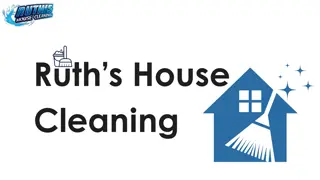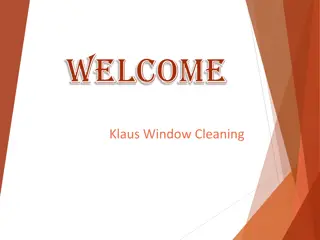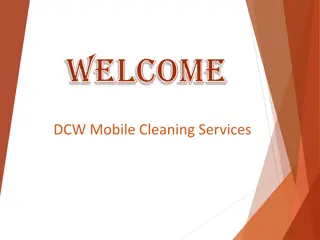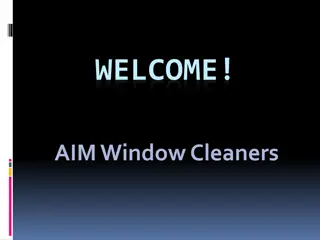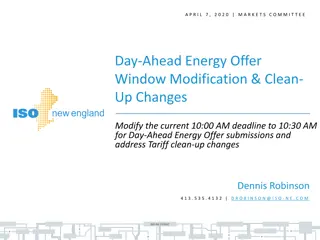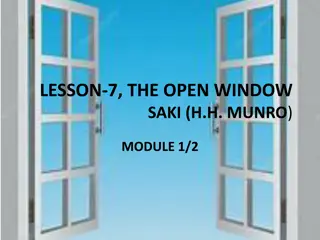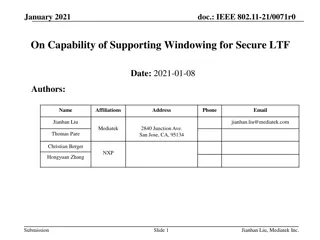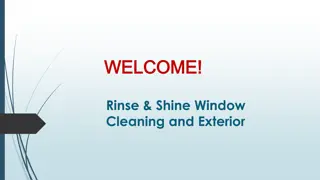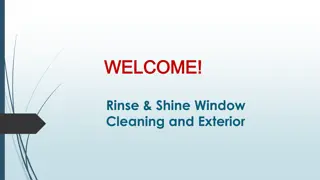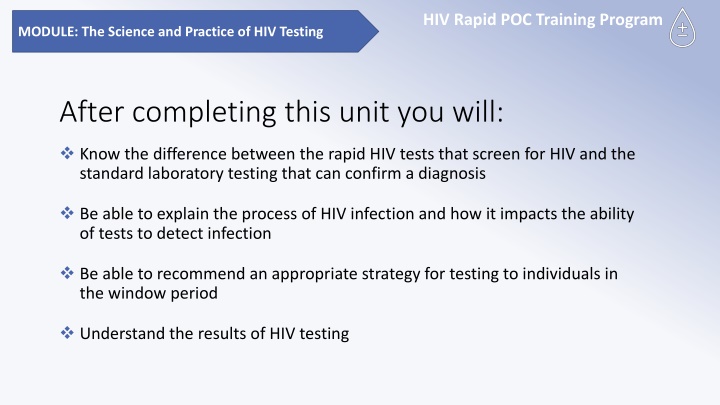
HIV Testing: Science and Practice of Rapid POC Testing
Explore the difference between rapid HIV screening and standard laboratory testing, learn about the impact of HIV infection on testing accuracy, and understand strategies for testing during the window period. Discover the process of HIV testing and the significance of results in this comprehensive training module.
Download Presentation

Please find below an Image/Link to download the presentation.
The content on the website is provided AS IS for your information and personal use only. It may not be sold, licensed, or shared on other websites without obtaining consent from the author. If you encounter any issues during the download, it is possible that the publisher has removed the file from their server.
You are allowed to download the files provided on this website for personal or commercial use, subject to the condition that they are used lawfully. All files are the property of their respective owners.
The content on the website is provided AS IS for your information and personal use only. It may not be sold, licensed, or shared on other websites without obtaining consent from the author.
E N D
Presentation Transcript
HIV Rapid POC Training Program MODULE: The Science and Practice of HIV Testing After completing this unit you will: Know the difference between the rapid HIV tests that screen for HIV and the standard laboratory testing that can confirm a diagnosis Be able to explain the process of HIV infection and how it impacts the ability of tests to detect infection Be able to recommend an appropriate strategy for testing to individuals in the window period Understand the results of HIV testing
HIV Rapid POC Training Program MODULE: The Science and Practice of HIV Testing What is a Screening Test? A screening test is a fast, simple test used to assess the health of a large group of people. Screening tests are designed to reliably identify people who do not have HIV, and flag people who need further testing. It is not a diagnostic test. Reactive tests require diagnostic testing to confirm results. Am I interested in someone? Tinder = screening A date = diagnostic What is a Diagnostic Test? A diagnostic test confirms that a person has been infected or an illness. It usually takes longer and is more complex to perform than a screening test.
HIV Rapid POC Training Program MODULE: The Science and Practice of HIV Testing HIV Testing in Ontario There are two ways that people can be tested for HIV in Ontario: Rapid point-of-care testing can be done quickly and easily, collecting blood with a finger prick and providing results all in the same appointment. This is a screening test, used in Ontario to screen the populations most at risk of HIV infection. Name Standard HIV testing is done by the Public Health Ontario Laboratory (PHOL). Blood must be collected in a tube for testing and sent to the lab. More than one test is done on any reactive result, which makes this testing diagnostic.
HIV Rapid POC Training Program MODULE: The Science and Practice of HIV Testing The Things HIV Tests Can Measure IgG Antibodies are created by the cells of the immune system. We create unique antibodies to attack each disease we are exposed to. During HIV infection, two types of antibodies are produced: IgM and then IgG. The presence of one or both of these antibodies is proof of HIV infection. IgM Measuring HIV directly by identifying the virus in the blood is also a way to know if infection has happened. The protein p24 is one measurable part of HIV. Concentrations of detectable p24 spike early in the process of infection and then become undetectable when antibodies are produced. p24 is usually detectable before the body has produced antibodies. The presence of p24 is proof of HIV infection.
HIV Rapid POC Training Program MODULE: The Science and Practice of HIV Testing HIV Infection Timeline New infection may cause flu- like symptoms and/or rash known as acute HIV infection; usually 2-4 weeks after infection for 1-2 weeks The virus Can measure in the blood Eclipse period antibodies Frequent symptoms fever muscle pain swollen lymph nodes sore throat rash GI (nausea, diarrhea, etc.) headache and fatigue p24 3 months (12 weeks) 3 weeks infection 6 weeks Acute HIV Infection
HIV Rapid POC Training Program MODULE: The Science and Practice of HIV Testing Testing Limits No routine test will detect HIV until the virus reaches the blood (1-2 weeks) after infection Standard HIV Testing in Ontario Rapid Testing Measures antibodies Measures antibodies and p24; reactive or unclear results are confirmed with additional tests Detects 80-90% of infections during acute HIV infection Detects 70-80% of HIV infections during acute HIV infection These tests are able to identify 95% of infections by six weeks (or more for the standard tests) and >99.6% at three months
HIV Rapid POC Training Program MODULE: The Science and Practice of HIV Testing What is the Window Period? The first part of the infection process when tests may not be able to detect all infections 3 months As testing technology improves, more infections can be detected within the window period. The amount of virus in the body peaks during the window period, and particularly in the first six weeks. A person is more at risk of transmitting the virus to others during the window period, compared to later in infection.
HIV Rapid POC Training Program MODULE: The Science and Practice of HIV Testing Talking to Clients about the Window Period Point of care testing focuses on working with clients from at risk populations to identify new infections as soon as possible, and to encourage people with negative tests to protect themselves and others. 1. Not everyone is infected by a high-risk exposure. However, if infection occurs, the levels of virus rise quickly in the early stages. Advise abstinence, condoms and harm reduction to protect others while in the window period. 2. Point-of-care testing will identify most new infections earlier than three months, however standard laboratory testing is more likely to detect infection early. At three weeks (or any time while the client still has seroconversion symptoms), perform a rapid test if requested, but also advise the client to submit a sample for standard laboratory testing. Recommend at-risk clients return for testing at 3 weeks 6 weeks 3 months 3.
HIV Rapid POC Training Program MODULE: The Science and Practice of HIV Testing The 3-6-3 Testing schedule For clients from at-risk populations who have had a specific exposure to HIV (through sex or other blood contact), and where the counsellor s assessment suggests significant risk.* This schedule offers the greatest likelihood of identifying HIV as soon as possible. Date of possible exposure 3 weeks 3 months 6 weeks RECOMMEND: POC + STANDARD TESTING POC TESTING POC TESTING Many early infections can be detected; standard lab testing should be recommended to maximize detection. Over 99.6% of people with HIV test positive 95% of infections can be detected with the rapid test * If the counsellor deems the risk of HIV infection is modest, it is appropriate to offer an initial test with follow-up testing 3 months after the incident of concern to the client.
HIV Rapid POC Training Program MODULE: The Science and Practice of HIV Testing PEP and the Window Period Post-Exposure Prophylaxis (PEP) is the use of antiretroviral drugs to prevent infection after an exposure has occurred. Key Messages for Clients seen in the First 72 Hours after Exposure PEP can reduce the risk of HIV infection by 80% if taken within 3 days of exposure and continued consistently (28 days). If your site does not provide PEP, suggest clients go to a hospital emergency room to get PEP. Ongoing Messages for PEP Clients If PEP use is not able to eliminate the HIV virus, it may make the new infection harder to detect. Diagnosis may not be possible until later in the window period. Stress that a client who took PEP should be tested at three months. PEP During follow-up testing, it is appropriate to suggest that clients who have taken PEP consider PrEP use for ongoing protection. If a client is at high-risk and their test is non- reactive, suggest PrEP counselling and refer them if they are interested.
HIV Rapid POC Training Program MODULE: The Science and Practice of HIV Testing PrEP and the Window Period Pre-Exposure Prophylaxis (PrEP) is the ongoing use of antiretroviral medications to prevent HIV infection. Key Messages for Clients PrEP use can reduce a client s risk of HIV infection. If a client is at high-risk and their test is non- reactive, suggest PrEP counselling and refer them if desired. If PrEP is not taken regularly as prescribed, it may not be able to prevent infection. If this was an at- risk client s only protection against infection (i.e. if they did not use condoms), anal or vaginal sex, should be considered a high risk exposure PrEP If PrEP use was inconsistent and did not prevent HIV infection, the presence of some drug in the body may make the new infection harder to detect. Diagnosis may not be possible until later in the window period. Stress that a client who took PrEP should be tested again at three months. Never discourage a renewed commitment to PrEP use to simplify detection!
HIV Rapid POC Training Program MODULE: The Science and Practice of HIV Testing Interpreting Test Results Rapid POC Screening Reactive The individual may be infected with HIV. Ask to draw blood for standard testing. Do not minimize the likelihood of the subsequent test being positive, most are. Begin arrangements to link this individual to follow-up care. Name Non-Reactive The individual is not infected with HIV OR is in the window period. If there has been a high risk exposure the test should be repeated on the 3-6-3 schedule. Refer high-risk individuals to PrEP counselling or other services as needed. Name
HIV Rapid POC Training Program MODULE: The Science and Practice of HIV Testing Interpreting Test Results Standard Lab Test Positive for HIV 1 or Positive for HIV 2 antibody HIV infection confirmed. Prompt treatment protects the client s health. Offer HIV treatment as soon as possible, ideally within 72 hours. Evidence of HIV 1 infection prior to seroconversion HIV infection confirmed, even though antibodies are not yet measurable. Likely a recent infection, and the person is still in the window period. Prompt treatment protects the client s health. Offer HIV treatment as soon as possible, ideally within 72 hours. HIV antibody-Non-Reactive There is no sign of HIV infection. The person is not infected or is in the window period. If there has been a high risk exposure, the test should be repeated on the 3-6-3 schedule. Refer high-risk individuals to PrEP counselling or other services as needed.
HIV Rapid POC Training Program MODULE: The Science and Practice of HIV Testing What does an inconclusive result mean? In very rare cases, the public health lab may report that a test is inconclusive; in this circumstance the laboratory has already done several kinds of testing looking to confirm the presence of the antibodies and the virus. None of these tests have clearly shown that the person has HIV, nor have they ruled out HIV infection. The Public Health Laboratory recommends that a new sample be submitted for additional testing after at least four weeks. Inconclusive results are very rarely confirmed to be HIV positive; however if a person has had a potential exposure they should be advised that condoms and harm reduction are essential to protect others.
HIV Rapid POC Training Program MODULE: The Science and Practice of HIV Testing Can the test be wrong (false positive/reactive)? Any test can be wrong, but modern HIV tests are very specific and rarely wrong Name Standard Public Health Lab Testing Public Health uses several tests to confirm every positive test. Evaluation suggests it could be falsely positive/reactive less than 3 times in every 10,000 tests A single rapid test The manufacturer suggests it could be falsely reactive 4 times in every 1000 tests




